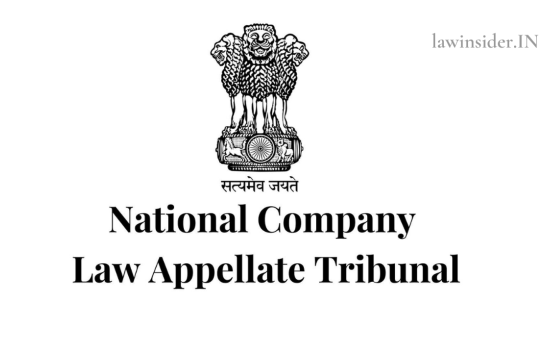Parth Mendole
The National Company Law Tribunal (NCLT) and National Company Law Appellate Tribunal (NCLAT) is a successor of the Company Law Board which was set up under the Companies Act, 1956.
It was established by the Central Government in the year 2016 under section 408 of the companies Act 2013, which was recommended by the V.Balakrishna Eradi Committee and it was later constituted on June 1, 2016. Since then a difference could be witnessed in the functions and powers of NCLT under the previous Companies Act and present Act of 2013.
The government has appointed 11 benches all over India with the Appellate Tribunal located in New Delhi. Members of this Tribunal are selected by a selection committee headed by the secretary of the Corporate Affairs Ministry (MCA).
What is NCLT?
National Company Law Tribunal is a Quasi-judicial authority incorporated to deal with the corporate disputes which are of civil nature and are aroused under the Companies Act.
NCLT is authorized to work in the footsteps of the normal court of law in the country and is obliged to fairly and without any biases regulate the facts of every case and to decide each matter in accordance with principles of natural justice.
The Order formed by NCLT assists to resolve a situation, correct a wrong done by and corporate, can put penalties, and has the power to alter the rights, duties, obligations, privileges of the concerned parties.
About NCLAT
An appeal against the decision of NCLT can be filed at National Company Law Appellate Tribunal (NCLAT). This Authority was formed under the Companies Act, 2013, for hearing appeals against the judgment given by NCLT Judgement.
It also entertains the appeals against the orders passed by the Insolvency and Bankruptcy Board of India (IBBI). And if still, someone is not satisfied with the decision given out by NCLAT, one can appeal in front of the Supreme Court of India.
What are the Main functions of NCLT?
Companies Registration
Because of procedural errors during the incorporation and registration, the new Companies Act, 2013 has enabled questioning the legitimacy of companies. It has been authorized in taking several steps, such as cancelling the registration of a company or dissolving any company in specific situations when the registration certificate is obtained by illegal or wrongful manner under section 7(7) of the companies Act, 2013.
Transferring of shares
NCLT is also empowered to hear grievances of rejection of companies in transferring sharing and securities. Under the Companies Act, 1956 the only solution which was available for rejection of transmission or transfer was limited to shares and debentures of the company but now it also covers the securities which are issued by any company.
Deposits
Deposits were notified several times in 2014 which is given in Chapter V of the Act. The company law Board was the primary authority who takes the cases under said chapter. But now such powers under Chapter V of the Act are vested with NCLT.
Which were notified even before the inception of the act. Unhappy depositors now have a remedy of class actions suits for seeking remedy for the omissions and acts on part of the company that impacts their rights as depositors.
Investigation Power
Previously the application of 200 members was required to investigate the affairs of the company. But as per the new provision of the Companies Act, 2013 only 100 members application is required. Besides, if a person is able to persuade NCLT about the presence of conditions for ordering an investigation then NCLT has the power for ordering an investigation. The investigation can be conducted in any part of the world.
Freezing the Assets
The NCLT is empowered to freeze the assets of a company for using them at a large stage when a company comes under any investigation or scrutiny. Also, such investigation can also be ordered on request of others on specific conditions.
Converting a public Company into a Private Company
Section 13-18 of the companies Act, 2013 controls the conversion of a public company into a private one, such conversion needs confirmation from NCLT. NCLT also has the power to impose conditions and restrictions under section 459 of the Act.
Mergers & Acquisitions
Scheme of Mergers and Acquisitions are adopted globally by the companies to survive in this world. Mergers and Acquisitions known as M&A are defined in the Companies Act, 2013. Below we will discuss what is merger and acquisition and its process.
Merger: – Merger is the collaboration of two or more companies to form a new company. In more simple terms, it can be defined as the agreement between two or more companies which merges with an aim to form a new company. It is done with the desire to widen its reach in every nook and corner of the market and to expand the business.
Acquisition: – is defined as the process of selling one company to another or when a company decides to amalgamate with another company to form a new company, this process is called acquisition. In acquisition target company has no desire to be purchased, that’s why it is also an also unfriendly deal.
Therefore, a purchasing deal between two companies often falls under the criteria of merger and acquisition depending on the type of purchase, i.e., whether the purchase is friendly or hostile.
Role of NCLT in M&A
The companies Act of 2013 has the provision of setting up the National Company Law Tribunal as discussed earlier, and it also gives the power to assume jurisdiction of high courts for sanctioning M&A deals between companies.
Its main aim was to ensure fair and effective overseeing of the deals. Thus, all mergers and acquisitions have to be carried out in accordance with the Companies Act, 2013. Section 230, 231, and 232 of the Companies Act, 2013 provides the role of NCLT in a merger and acquisition.
All the proceedings like Arbitration, Compromise, Agreements, Reconstructions, merger, de-merger, and the winding up of companies shall be disposed of by NCLT under the Companies Act, 2013. The bench of NCLT is chaired by a judicial member who is supposed to be a serving or retired High court Judge with a Technical member who must be from the Indian Corporate Law Service.
The procedure of merger and acquisition
Below given are the different Steps which M&A deal process include:
Setting a Strategy – The M&A starts with developing a strategy that includes several aspects. It gives a clear and motive idea of what to expect from a Merge and acquisition. The type of transaction they are willing to conduct, how much amount of capital they will be required to spend on this.
Searching and Contracting company – The acquire Company uses its identified search criteria to look for and company. A list of Potential companies is then made and then the acquiring company tries to contact the targeted company to express interest in them.
The purpose of this step is to obtain more information about the targeted company and to measure the level of interest in such a transaction.
Exchanging Information – when the initial conversation between the companies goes well and they share the interest in going ahead with the transaction.
They began the documentation which initially starts with signing the letter of intent to officially express the interest in the transaction, along with signing the confidential document assuring that the discussion and proceeding of the deal won’t go out.
After these companies exchange information about finance and company history for better assessment between the companies.
Performing valuation and synergies – after the process of exchanging the information, companies have enough information about each other they begin an assessment of the target and the deal as a whole.
The seller decides the best price that will cause again to him in the deal and the buyer asses the best reasonable offer for the target. The buyer tries to assess the extent of synergies in M&A that they can gain from this transaction in the forms of cost reduction, increased market power, etc.
Offer and Negotiation – after performing valuation the acquirer should have enough information about the transaction to construct a reasonable offer. Once the initial offer is presented, the companies negotiate the term of the deal.
The seller can negotiate for a better price if they feel that the offer is not reasonable. Another hindrance could be when the targeted company is a very attractive entity, there could be a competition among the buyers to offer the best price.
Due Diligence – After the offer is accepted from the buyer company, the exhaustive process of Due diligence begins. It consists of a thorough review of all the aspects of the company like assets and liabilities, costumers, human resources, financial merits, etc. It aims to confirm the buyer’s assessment of the value of the target company.
Purchasing of agreement – assuming that everything went well in due diligence with no major problems or concerns including the government approvals and no antitrust laws kicking in both parties begin drafting the final agreement.
Whether an asset purchase or share purchase. It also includes the time in which the payment would be made.
Integration and closing the deal – after the agreement is final, both the parties sign the document, the buyers control the target. After the closure of the deal, the human resources and management teams of both companies work together to integrate them into the merged entity.
Examples of Merger

1) Disney – Pixar Merger
The Disney-Pixar deal was announced on May 5, 2006. Disney made a separate subsidiary and acquired shares worth $7.4 billion of Pixar in an all-stock transaction. It is an example of a vertical merger.
Disney group is one of the largest media group in the world, while Pixar is an animation company which provides computer graphics for the movie. With this, Disney got the best technology of the best animation studios globally for its movies, while Pixar got the required capital to outdo its competitions. For this, Disney offered 2.3 shares of its stock to Pixar shareholders. That means by that price, Pixar shareholders receive a premium of 3.8%.

2) Exxon – Mobil Merger
Exxon Mobil deal was announced in 1998, and it was the largest till that time. The size of the agreement was $73.7 billion. Exxon was the largest energy company, while Mobil was the second-largest oil company in the whole US at that time.
With this, Exxon Mobil became the largest oil company and the third-largest company in the world. From this deal, Exxon shareholders owned 70% of the merged company, and Mobil shareholders were left with 30% shares of the new entity. Mobile shareholders received 1.32 Exxon shares for each Mobil shares. Mobil was valued at $76 bn in this deal.
Advantages
* Possible increase in market share: For example, if there is a competition among 3 companies. Instead of losing out of the third company,2 of any 3 Companies can form a merger and can gain a larger market share.
* Reduction in cost for operations: Another advantage can be, compared to the individual company the size of the merged company is larger. So, the total cost of operation can be reduced, because of the economy of scale.
* Growth in profit and revenue: Merged companies can achieve greater objectives easily in a short ample of time. Resulting in an increase in profit and revenue.
* Expanding operating to a new area: It is always difficult for a newly established company to get a start in a new market or geographies. That’s why it can merge with other companies where were already there in that area and can get the business started.
Disadvantages
* The biggest disadvantage can be the increase in the rate of goods and supplies because of the monopoly of one company.
* There could be some difficulty in coordination and communication between employees of the two companies.
* It is sometimes very costly because all the shareholders of merged companies want a premium on their shares.[2]
Conclusion
In the on-going time merges and acquisitions are happening commonly, sometimes even taking the shape of hostile and friendly transactions. Which is helping lots of companies in their growth and expansion.
The merging time period can be short or lengthy, depending on the complexity and size of the transactions. A merger could play a vital role for several companies to increase their market share or reducing the costs of products.
With now NCLT being established, it is now reducing the burden from the High court which before used to look after all the matters between companies, and also the time which was usually taken to obtain the sanction from the High court is now also reduced.
References: –
[2] – https://corporatefinanceinstitute.com/resources/knowledge/deals/mergers-acquisitions-ma-process/
[2] – https://www.wallstreetmojo.com/ma-process/

